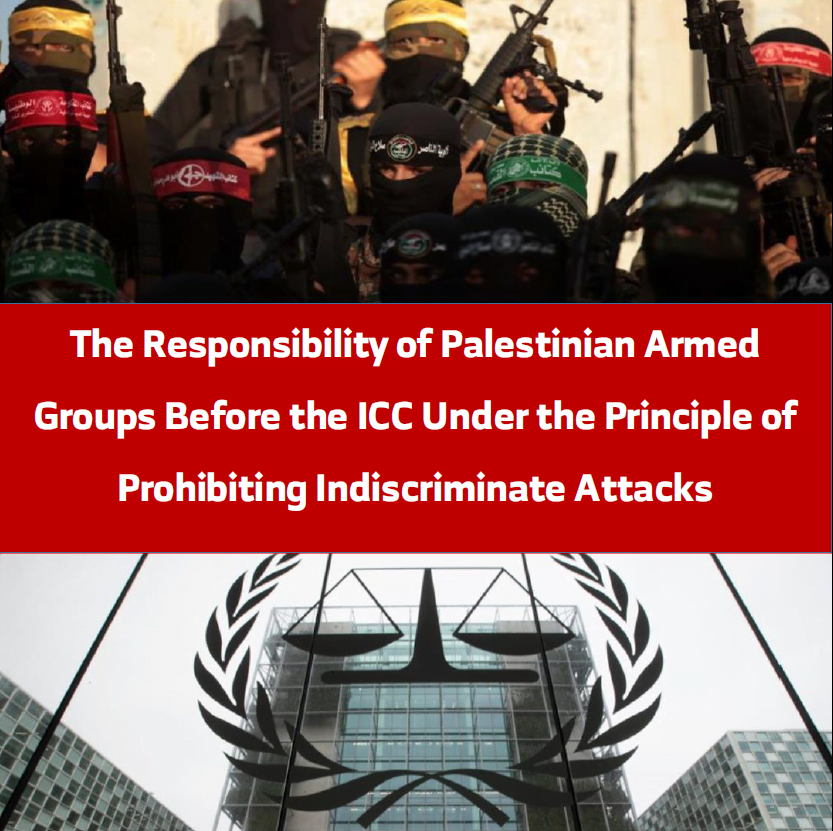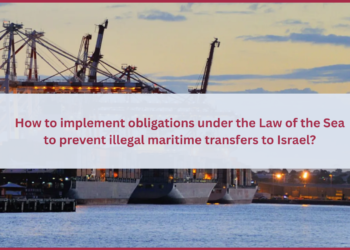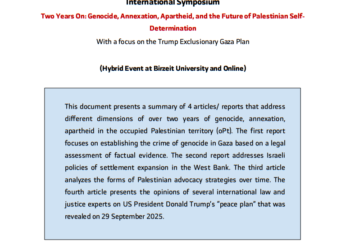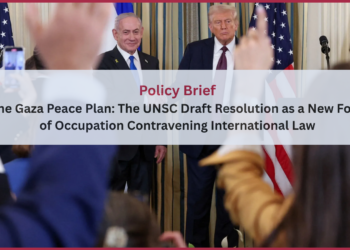Launching Rockets and the Responsibility of Palestinian Armed Groups Before the ICC Under the Principle of Prohibiting Indiscriminate Attacks
Prepared by: Eman Birat
Edited by: Hiba Birat
* This article was translated from Arabic to English by Mariam Hussam Alqam, and edited by Ahmed Almassri
* To download the paper in pdf format, click here (11 pages)
*This article is the first to be published in a series of articles on the “responsibility of Palestinian Armed Groups (PAGs) before the International Criminal Court (ICC)”, as part of the Law for Palestine’s call for submissions in this area.[1]
Introduction
In March 2021, the ICC former Prosecutor, Fatou Bensouda, declared in a statement the opening of an investigation into alleged war crimes in the occupied Palestinian territories. The statement was issued following the ICC Pre-Trial Chamber judges’ majority decision, on February 5th, 2021, that the Court’s territorial jurisdiction extends to the Palestinian territories occupied by Israel in 1967. The decision was opposed by Israel and some of its Western allies.[2]
Bensouda stated that there is a “reasonable basis” for an investigation into alleged war crimes in the Palestinian territories by both sides to the 2014 Gaza war, namely the Israeli Army and the PAGs, primarily Hamas. During the last Gaza war in May 2021, the Prosecutor warned all sides about escalation and cautioned against any action that may result in the commission of war crimes.
Consequently, this article addresses the extent to which the Palestinian armed groups (PAGs) are responsible before the ICC under the customary principle of precautions in attack and the prohibition of indiscriminate attacks. Furthermore, the article examines the extent to which actions by the PAGs in this regard may be considered war crimes.
Prohibition of indiscriminate attacks
International humanitarian law (IHL) is based on a set of rules that seek to spare civilians the scourge of war, including by the prohibition of indiscriminate attacks that may result in the loss of civilian lives and property. This IHL rule is intimately linked to the core of IHL through a series of articles relating primarily to the protection of civilians. Articles 47 and 27 of the Fourth Geneva Convention express the need to distinguish between civilian populations and combatants. They also require the distinction between civilian objects and military targets, so that civilian persons and their property cannot be deliberately or arbitrarily attacked. Article 51 of the Additional Protocol I to the Geneva Convention emphasizes civil and civilian objects’ protection from military attacks. Para. 4 clearly prohibits indiscriminate attacks. The prohibition of indiscriminate attacks was also clearly reflected in Rule 11 of customary international law,[3] which is binding on all states and relevant actors. Additionally, under Article 22, the Hague Regulations Concerning the Laws and Customs of War on Land of 1907 also recognized that “[t]he right of belligerents to adopt means of injuring the enemy is not unlimited.”
Definition and interpretation of the rule of prohibition of indiscriminate attacks
Additional Protocol I (1977) on international armed conflicts defined indiscriminate attacks in Article 51(4) as:
- a) those which are not directed at a specific military objective; or
b) those which employ a method or means of combat which cannot be directed at a specific military objective; or - c) those which employ a method or means of combat, the effects of which cannot be limited as required by this protocol; and consequently, are of a nature to strike military objectives and civilians or civilian objects without distinction.
Article 51(5) of the same protocol lists the following examples of what would constitute an indiscriminate attack:
- a) an attack by bombardment, by any methods or means, which treats a number of clearly separated and distinct military objectives located in a city, town, village or other area containing a similar concentration of civilians or civilian objects; and
- b) an attack which may be expected to cause incidental loss of civilian life, injury to civilians, damage to civilian objects, or a combination thereof, which would be excessive in relation to the concrete and direct military advantage anticipated.
Thus, Article 51(4) and Article 51(5) present two types of indiscriminate attack: The first involves the failure to identify a specific military target as an objective, and the second involves the use of weapons whose effects cannot be controlled after launch, because of the method or means of use, such as certain types of cluster munitions or chemical or biological weapons.[4]
The ICRC, in Customary Rule No. 12, commented that Article 51 is based on the logical argument that the means or methods of warfare whose effects cannot be limited as required by international humanitarian law should be prohibited.
Do unguided rockets launched from the Gaza Strip present a violation of this rule?
This question needs to examine the applicability of the conditions and determinants of indiscriminate attacks mentioned in Article 51(3) of the Additional Protocol I on rocket attacks by the PAGs towards Israeli cities. Given the conditions mentioned and the listed examples, at least two of the determinants have been met by Palestinian rocket attacks in previous wars, in particular the 2014 war. The types of rockets and mortars used are unguided and hence cannot hit their target with great accuracy because of their rudimentary construction. The impact of some of these rockets are difficult to limit to military targets, for example; the rockets fired towards Israeli military targets close to civilians and civilian objects.
It can be helpful here to review the report issued by the UN fact-finding mission established by the UNHRC to investigate allegations of war crimes in the context of the Israeli military operation conducted in the Gaza Strip between 2008-2009 (known as Goldstone report). The report investigated in part whether the launching of rockets by the PAGs into Israeli towns constituted a war crime. Despite that the time period which the report deals with does not fall within the ratione temporis of the ICC over the situation in Palestine, (which began on June 13th, 2014) we can still invoke certain guides and legal arguments mentioned in the report about rockets and mortars fired by the PAGs in the Gaza Strip towards Israeli areas.
The report explained that most of the rocket and mortar attacks by the PAGs on the civilian population of southern and other parts of Israel constitute indiscriminate attacks. This is because most of them have failed to hit military targets. On the other hand, and according to the report, “where there is no intended military target and the rockets and mortars are launched into civilian areas, they constitute a deliberate attack against the civilian population”. The report concludes that the rocket and mortar attacks by the PAGs are incapable of being directed towards specific military objects and have been fired into areas where civilian populations are based. The seeming inability of the PAGs “to aim rockets and mortars at specific targets and, the fact that the attacks have caused very little damage to Israeli military assets, it is plausible that one of the primary purposes of these continued attacks is to spread terror – prohibited under international humanitarian law”.[5]
In another report by the UN Commission of Inquiry, dispatched by the Human Rights Council, investigated the violations of international humanitarian law in the 2014 Israeli war in Gaza, which, ipso facto, falls within the jurisdiction of the Court. The report states that most of the rocket and mortar attacks fired by PAGs during the war towards Israeli civilian population areas lack precise targeting systems and therefore fall within the scope of indiscriminate attacks prohibited by international humanitarian law.
The report excludes the relationship between the PAGs’ inability to build advanced weapons with high and accurate control systems, and the prohibition of indiscriminate attacks
What is noteworthy here is that the report excludes the relationship between the PAGs’ inability to build advanced weapons with high and accurate control systems, and the prohibition of indiscriminate attacks.[6] Such attacks constituted war crimes even under such circumstances; and some international courts have even regarded them as a deliberate attack on civilians. The report states that these attacks, coupled with statements by Palestinian armed groups, strongly suggest that the primary purpose of the rocket attacks was to spread terror among the civilian population, in violation of international humanitarian law. [7]
According to the same report, the PAGs appear to have provided advance warning in a very few instances before launching attacks during the 2014 Gaza war. With regards to these instances of warnings, it appears that they were reflected in some of the effective advance warning requirements in Article 57(3) of Additional Protocol I, in particular the requirement that the warning could be acted upon. There are suspicions regarding the effectiveness of these warnings i.e. whether they fulfilled the requirement of reaching the target audience and being understood. It appears that the warnings were broadcast in the media. It is not clear if this transmission method was sufficient at that time to ensure it reached the intended public. However, it is also not clear what other methods of transmitting the warnings were available to armed groups in Gaza.[8]
It also should be noted that, during the May 2021 Israeli war in Gaza, the Izz Al Din Al Qassam Brigades of Hamas regularly issued statements and advance warnings before launching the rockets, which seems to have come as taking a leaf from the 2014 war. These statements were broadcast on the Internet and transmitted on global television networks. They included clear threats to Israeli cities to locate and determine the time of the attack. A number of Israelis shared on social media that they relied on these statements and followed them to find out whether the bombing had continued or stopped. This means that the newly formed commissions of inquiry may conclude that these warnings are effective under international humanitarian law and Article 57(3) of Additional Protocol I to the 1977 Geneva Conventions. On the other hand, it might be considered as not sufficient, being in Arabic instead of Hebrew, the language used by the majority of the population in Israel.
Palestinian rockets, indiscriminate attacks, and responsibility before the ICC
International humanitarian law contains a general principle relevant to the prevention of indiscriminate attacks, according to which all feasible precautions must be taken when attacking military targets to avoid incidental loss of civilian life through negligence. At another level, an indiscriminate attack in practice amounts to an attack on civilian lives when it violates the principle of proportionality. Whereby, international humanitarian law prohibits military attacks that are expected to cause excessive damage to civilians compared with the expected military advantage. This is known as the “Principle of Proportionality”.
Although the notion of inflicting “excessive” harm in itself recognizes that civilian casualties may be unavoidable when targeting legitimate military objects, its absence means that there is some kind of criminal intent.
As aforementioned, indiscriminate attacks have been clearly and directly criminalized in international humanitarian law, however, their characterization and responsibility vary according to their consequences and goals. Indiscriminate attacks that do not respect the principle of precautions in attack and proportionality are considered grave breaches of the Geneva Conventions, according to Article 147 of the Fourth Geneva Convention, and a war crime under Article 8(b) of the Rome Statute. Violence aimed at spreading terror among the civilian population are also prohibited.
To what extent can the actions of the PAGs be considered crimes within the jurisdiction of the International Criminal Court?
In her report regarding the case of Palestine, Fatou Bensouda, the ICC Prosecutor at that time, declared that there is a convincing and reasonable basis to believe that war crimes have been or are being committed in the Palestinian territories. Bensouda said that there is “a reasonable basis to believe” that members of Hamas and the PAGs committed the war crimes of: intentionally directing attacks against civilians; using protected persons as shields; willfully depriving protected persons of the rights to fair and regular trial; and torture.
The Prosecutor did not mention indiscriminate attacks in the context of her census, but indicated that these were only examples of what could be investigated, and that the investigation would not be limited to such examples (Para. 99).
By examining this issue under the Rome Statute governing the ICC, Article (8)(2)(b) of the Rome Statute on war crimes, which has been relied upon in previous 2009 and 2014 UN reports as a description of PAG attacks, contains a prohibition of certain acts that may be related to indiscriminate attacks. Such attacks include: wilful killing, intentionally directing attacks against the civilian population as such, intentionally launching an attack in the knowledge that such attack will cause incidental loss of life or injury to civilians or damage to civilian objects or widespread, long-term and severe damage to the natural environment which would be clearly excessive in relation to the concrete and direct overall military advantage anticipated, and attacking or bombarding, by whatever means, towns, villages, dwellings or buildings which are undefended and which are not military objectives.
Such war crimes within the substantive jurisdiction of the ICC generally involve two elements; material and mental, both of which must be present to hold the crime’s responsibility before the ICC.
The material element of the crimes mentioned include these determinants: the victim or victims are protected under one or more of the Geneva Conventions of 1949; the perpetrator was aware of the factual circumstances that established that protected status; the conduct took place in the context of and was associated with an international armed conflict; and the perpetrator was aware of factual circumstances that established the existence of an armed conflict.
Depending on the aforementioned types of war crimes that fall within the jurisdiction of the ICC and may have relations to PAG acts, the material elements vary. For example, if indiscriminate attacks actually cause civilian loss, and it was clear from the statements of PAG officials, or from the ground realities, that they wanted to reach this objective, then this act would be considered a wilful killing, which requires an additional element, in which the perpetrator killed one or more persons.
In addition to the aforementioned crimes, para. 20 of Article (8)(2) of the Rome Statute prohibits “[e]mploying weapons, projectiles… which are inherently indiscriminate… provided that such weapons, projectiles… are the subject of a comprehensive prohibition and are included in an annex to this Statute,” which is not the case for PAG rockets.
Moving to the second element of war crimes, the mental element: as stated in article 30 of the Rome Statute[9], a person shall be criminally responsible when the material elements are committed with: intent and knowledge. In other words, the person has knowledge of the possibility of anticipating the event or outcome in the ordinary course of events, and would intentionally cause that event or its outcome. According to the Elements of Crimes of the ICC, the existence of intent and knowledge can be inferred from relevant facts and circumstances.
In order to examine the applicability of the elements of these war crimes to the actions of the PAGs and their indiscriminate rocket attacks, the Court will have to consider the mental element (intent and knowledge) and the extent to which it exists. Moreover, the Court will have to examine the casualty figures and the kind of damage caused to civilians or civilian properties in order to establish the aforementioned material elements of these crimes.
The actions of the aforementioned armed groups should be characterized by the gravity threshold, which is a fundamental constitutive criterion to assess the admissibility of a case before the Court
Moreover, the actions of the aforementioned armed groups should be characterized by the gravity threshold, which is a fundamental constitutive criterion to assess the admissibility of a case before the Court. This is crucial for determining the responsibility of the PAGs and whether their indiscriminate attacks have sufficient gravity to justify further action by the ICC.[10] For instance, the International Criminal Tribunal for the Former Yugoslavia, in the Tadić case in 1995, stated that, in order for an offence to be subject to prosecution before the Tribunal, “the violation must be serious, that is to say, it must constitute a breach of a rule protecting important values, and the breach must involve grave consequences for the victim.” This was also mentioned, in general terms, in the Kupreškić case.[11]
In the case of the Mavi Marmara flotilla, which had the flag of Comoros, a member of the ICC, sailed for a humanitarian mission with an aim to break the Israeli blockade on Gaza in May 2010. The flotilla was intercepted by the Israeli soldiers on high sea; 9 civilians were killed and 55 others were wounded. Despite that the Prosecutor of the ICC stated in her report on the situation that: “there is a reasonable basis to believe that war crimes were committed, within the jurisdiction of the ICC, (…) on board of one of the vessels during the interception”, nevertheless she concluded that the potential case(s) that would likely arise from an investigation of the flotilla incident would not be of “sufficient gravity” to justify further action by the Court; stressing that the Court’s jurisdiction prioritises war crimes as part of a plan or policy or as part of a large-scale commission of such crimes”.
With regard to the crimes of British soldiers in Iraq, the Prosecutor of the ICC at the time found in a report in 2006 that the alleged committed crimes “did not reach the threshold of gravity” because of the limited number of victims. The Prosecutor stated that the number of potential victims of crimes within the jurisdiction of the Court in this situation is 4 to 12 victims of willful killing and a limited number of victims of inhuman treatment – hence, the investigation was not launched.[12]
When looking at the attacks by the PAGs on Israeli cities, it can be found that in the 2014 war, according to the United Nations, 4881 rockets and 1753 mortars were fired towards Israel. The Israeli death toll was 70, only 6 of whom were Israeli civilians, as most of the mortars and rockets fired from Gaza hit open/uninhabited areas.
In contrast, the military capabilities of the PAGs appear to have advanced in the recent Israeli war in May 2021 on Gaza. According to a BBC report, 12 Israelis died following the armed attacks during the war, however, their civilian status was not indicated by the military, and 336 Israelis were injured. According to an Israeli army statement, the number of rockets fired was 4070, 90% of which were intercepted by the Iron Dome.
Today, in the light of the decision of the OHCHR to establish a commission of inquiry to investigate violations in Gaza, and in Israel in the past war, the image will become clearer in terms of casualty types, and the classification of the attacks launched by the PAGs as war crimes or not.
Conclusion
In a war based on resorting to violence and force, international humanitarian law establishes a proportional relationship between human protection and the use of force. The principle of proportionality is of great importance in this context to assess the argument of military necessity when evaluating the legality of the use of armed force. In the war between Israel and the Gaza Strip, PAGs possess simple technology and weapons, which lack high targeting capacity, despite the discrepancy between these capabilities in the four wars of 2008/9, 2012, 2014 and the last war in 2021.
Although a UN report on the 2021 war has not yet been issued, under the previous UN reports of 2009 and 2014, it can be concluded that the majority of the rocket attacks of the armed groups fall within the scope of indiscriminate attacks resulting in a few civilian casualties. Israeli officials and media are silent about the physical damage caused by these attacks. The picture remains unclear regarding the occurrence of war crimes and their different classifications, as well as the need to prove that the actions of the PAGs were made with prior knowledge and intent (mental element). Nonetheless, these attacks appear to be closer to war crimes, especially those aimed at spreading terror and which cause limited material damage.
The newly formed Commission of the HRC may conclude otherwise for the developments of the military arsenal of armed groups. The ICC may even disagree with these reports. Both the Commission report and the ICC investigation may suggest that the attacks do not fall within the scope of indiscriminate attacks. However, the essence of international humanitarian law remains the general principle that, exercised reasonable and feasible care must be taken when attacking military targets so that civilians are not unnecessarily injured due to negligence. In addition to the combination of other legal principles against discrimination and immunity of civilians on the one hand, and the right to self-determination and legitimate armed defense on the other, not to mention the actual circumstances of the Gaza Strip, the details of the military operations of the PAGs, and the extent to which there exists a “gravity threshold” may play a role in adapting and dealing with the classification of the attacks.
In general, these facts undoubtedly raise the urgent need to develop international humanitarian law to deal with guerrilla wars and wars of liberation movements. These were recognized in 1977, in the Additional Protocol I to the Geneva Conventions as legitimate wars to which international humanitarian law conventions apply. To demand that the PAGs do not resort to using their arsenal of rockets means to demand that they sit idly by as the Israeli aircraft forces bomb the Gaza Strip, including the targeting of civilians, because they do not possess the advanced means of combat through which their resistance can be accurately directed. Does this mean the alternative is to use indiscriminate rockets? Of course not. That could be a war crime as previously elaborated. New rules and regulations need to develop in such situations. Many questions remain unanswered; only the commencement of an effective investigation and progress in the judicial process before the ICC can provide the much-needed answers to these and to other relevant questions.
[1] Law for Palestine bears no responsibility for the content of the articles published on its website. The views and opinions expressed in these articles are those of the authors and do not necessarily reflect the official policy or position of the Organisation. All writers are encouraged to freely and openly exchange their views and enrich existing debates based on mutual respect.
[2] Israel condemned the decision of the International Criminal Court to open an investigation into the Palestinian territories. Benjamin Netanyahu remarked that the Court had once again proved to be a political body rather than a judicial institution. The Court’s decision undermined the right of democratic regimes to defend themselves against terrorism. The United States expressed its “deep concern” about the ICC decision. US State Department Spokesman Edward “Ned” Price stated to journalists “We are deeply concerned by the attempts of the ICC to exercise jurisdiction over the Israeli military. We have always taken the position that the jurisdiction of the Court must include exclusively those countries that accept it or (the cases) referred by the Security Council to the court.”
[3] The Customary International Law Database was launched by the International Committee of the Red Cross in August of 2011, and was developed to be used as a legal reference in international and non-international wars by courts, tribunals and international organizations.
[4] See ICRC, Customary International Humanitarian Law, Volume I: Rule 12.
[5] See Report of the United Nations Fact-Finding Mission on the Gaza Conflict, 2009, p. 365
[6] See Report of the detailed findings of the Commission of Inquiry on the 2014 Gaza Conflict A/HRC/29/CRP.4, p.29
[7] Ibid
[8] Ibid, p.28
[9] Article 30 of Rome Statute states: 1. Unless otherwise provided, a person shall be criminally responsible and liable for punishment for a crime within the jurisdiction of the Court only if the material elements are committed with intent and knowledge. 2. For the purposes of this Article, a person has intent where: (a) In relation to conduct, that person means to engage in the conduct; (b) In relation to a consequence, that person means to cause that consequence or is aware that it will occur in the ordinary course of events. 3. For the purposes of this article, “knowledge” means awareness that a circumstance exists or a consequence will occur in the ordinary course of events. “Know” and “knowingly” shall be construed accordingly.
[10] As mentioned, the margin in the number of causalities shows that the victims among the Israelis are low, and that most of them are soldiers; which raises the question about satisfying the gravity threshold in accordance with civilian damage. The situation may differ when talking about material or moral damage, for which we do not have a clear conception about because of the absence of the official Israeli version of the picture. Israel refused to cooperate with the UN investigation committees and the International Criminal Court.
[11] See International Committee of the Red Cross. Customary International Humanitarian Law: Volume 2: The Rules, Rule 156
[12] In 2014, the Court reopened the case after additional information was provided on this case.







